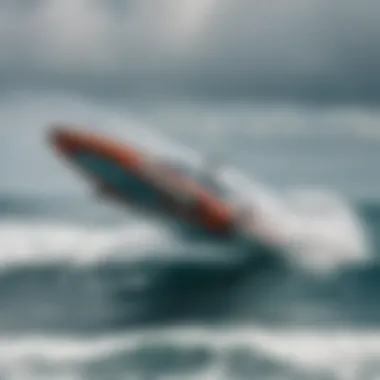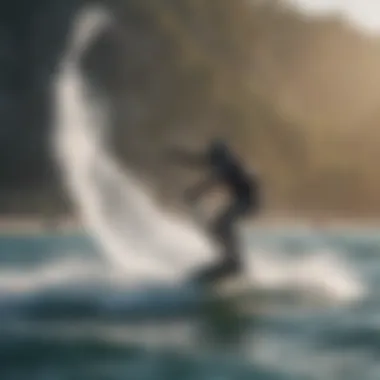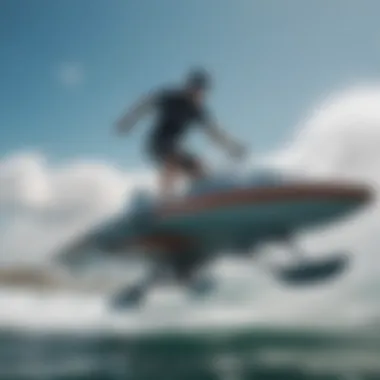Understanding Hydrofoils for Kiteboarding Enthusiasts


Intro
In recent years, hydrofoils have made quite a splash in the kiteboarding scene, igniting conversations among enthusiasts and professionals alike. These fascinating devices elevate riders above the water's surface, offering a unique and exhilarating experience that sets them apart from traditional boards. As kiteboarding continues to evolve, understanding the intricacies of hydrofoils becomes increasingly essential for anyone looking to enhance their sessions on the water.
But what exactly is a hydrofoil? At its core, a hydrofoil is a submerged wing-like structure that generates lift when moving through the water, allowing the rider to glide smoothly above the surface. The appeal lies not only in the thrill it provides but also in its efficiency. With the right setup, riders can harness the power of the wind with fewer limitations and experience less drag.
As we journey through this comprehensive guide, we will illuminate key points, covering not just the technical specifications but also the practicalities of gear selection and skill development. From selecting the right equipment to mastering essential techniques, this exploration aims to provide kiteboarders—whether novice or expert—with valuable insights and directions for their hydrofoil adventure.
Preface to Hydrofoils
In the world of kiteboarding, understanding the nuances of hydrofoils is essential for both aspiring and seasoned riders. Hydrofoils, although they might seem like a new addition to the kiteboarding scene, embody a fascinating blend of technology and nature that can profoundly enhance the kiteboarding experience. This section delves into the fundamental aspects of hydrofoils, laying the groundwork for a deeper exploration of the mechanics and advantages they offer.
Definition and Basic Principles
At its core, a hydrofoil is a wing-like structure that extends below the waterline, typically attached to a kiteboard via a mast. As the board gains speed, the hydrofoil generates lift—much like an airplane wing does in the air—that raises the board above the surface of the water. This unique characteristic allows riders to glide effortlessly, cutting through waves and reducing drag.
Understanding the basic principles of hydrofoils involves grasping concepts such as lift, drag, and the fluid dynamics that allow them to function. When a hydrofoil moves through water, it displaces water beneath it, creating a low-pressure area above the wing and a high-pressure area below. This pressure difference generates lift, allowing the rider to soar above the water, where conditions are often smoother and faster.
"Hydrofoils combine physics and artistry, enabling a dance upon the water that defies traditional kiteboarding limitations."
Hydrofoils are not merely about innovation; they significantly enhance performance. Riders can achieve higher speeds due to reduced drag, thus experiencing a new level of thrill and excitement. The efficiency gained from gliding above the surface results in less energy expenditure, making it easier for riders to maintain longer sessions with less fatigue.
The Evolution of Hydrofoils
The story of hydrofoils is a tale of evolution that mirrors advancements in technology and a growing understanding of aerodynamics and hydrodynamics. Initially, hydrofoils were introduced to sailing and racing in the early 20th century, with designers experimenting with different shapes and configurations to optimize performance on water. Over the years, as materials improved and research expanded, hydrofoils found their way into various water sports.
In kiteboarding, the adoption of hydrofoils has transformed the landscape. Early models were rudimentary and often challenging to control. However, advancements in design, fin technology, and materials have led to a wave of innovations that cater to a broad spectrum of rider skill levels. New hydrofoils are not just refined versions of their predecessors; they incorporate features that enhance stability, maneuverability, and ease of use.
Today, hydrofoils have become a staple in the kiteboarding arsenal. From beginners to elite competitors, riders are tapping into the versatility and excitement that hydrofoiling offers. This evolution not only speaks to the ingenuity of designers but also reflects the ever-growing enthusiasm within the kiteboarding community for pushing the boundaries of the sport.
Understanding hydrofoils is the gateway to elevating one’s kiteboarding skills and experiences. With the groundwork laid in this section, readers can now progress to explore the intricate mechanics of hydrofoil technology, further enriching their knowledge and engagement with the sport.
The Mechanics of Hydrofoil Technology
Understanding the mechanics behind hydrofoil technology is essential for any kiteboarding enthusiast looking to elevate their game. The complex interplay of aerodynamic and hydrodynamic forces allows kiteboarders to achieve new heights and speeds with relative ease. These mechanics are not merely technical; they fundamentally shape the rider's experience in numerous ways. Take, for example, the sensation of gliding smoothly above water—this is a direct result of the principles at play in hydrofoil design and operation.
Aerodynamics and Hydrodynamics
When discussing the mechanics, it’s crucial to differentiate between aerodynamics and hydrodynamics. Aerodynamics involves how air interacts with solid bodies—in this case, the kite and the rider—while hydrodynamics deals with the interaction between the water and the hydrofoil itself.
In kiteboarding, the shape of the foil wings is specially designed to optimize airflow. The curvature and angle of attack determine how efficiently the wing generates lift. It’s fascinating to note that small adjustments can lead to large differences in performance. On one hand, a well-designed hydrofoil allows the kiteboarder to glide effortlessly over the water. On the other, poor aerodynamics can mean struggling against the pull of gravity and the drag of water.
Key Components of Hydrofoil Boards
The components of a hydrofoil board are integral to its functionality. Understanding each part helps you appreciate how they collectively work to enhance the kiteboarding experience.
Foil Wings
The foil wings are perhaps the most vital aspect of hydrofoil technology. They act like airplane wings, generating lift and facilitating lift-off from the water. The specific design of the wings impacts how quickly a rider can get up on the foil and how efficiently they glide once there.
- Key Characteristic: Foil wings have a large surface area that helps in maximizing lift, even at lower speeds.
- Unique Feature: The aspect ratio, which is the ratio of the wingspan to the chord width, can vary. Longer wings usually provide better lift but can be less maneuverable.
- Advantages: A higher aspect ratio wing, for example, is excellent for speed but might sacrifice agility in tight turns.
Masts
The mast connects the board to the foil, and its height plays a significant role in how the entire setup performs on the water. A longer mast can allow for smoother rides through choppier water, creating a more stable experience for the rider.
- Key Characteristic: Masts come in different lengths, and choosing the right one could influence how much control you have while riding.
- Unique Feature: Some masts are adjustable, allowing riders to customize their setup based on conditions.
- Advantages: A longer mast can be beneficial for those who tackle bigger waves, while a shorter one might make tricks easier for more advanced maneuvers in calmer waters.
Fuselage
The fuselage connects the wings and the mast, playing an integral role in the overall geometry of the hydrofoil. It often gets overlooked, yet its importance cannot be stressed enough.


- Key Characteristic: A sturdy fuselage ensures stability and proper alignment of the wings.
- Unique Feature: Some advanced setups allow for interchangeable fuselages, giving flexibility to customize performance.
- Advantages: A well-designed fuselage contributes to better balance when foiling, enhancing the rider’s ability to control maneuvers.
How Hydrofoils Function
Now, let’s consider the functionality of hydrofoils by delving into lift and drag.
Lift and Drag
One cannot overlook this dynamic duo in the context of hydrofoil technology. Lift is what gets riders out of the water, while drag is the adversary that one must overcome.
- Key Characteristic: Lift is generated when the water flows over the wings at a certain speed, creating a pressure difference.
- Unique Feature: The angle of attack of the foil wings significantly influences the lift produced.
- Advantages: An effective lift-to-drag ratio leads to less energy expenditure, meaning longer sessions on the water.
Stability and Control
Stability and control are essential for a pleasant ride. When using hydrofoils, achieving a proper balance between these two elements is crucial.
- Key Characteristic: Many modern hydrofoil setups include features designed to improve stability, such as wider wings or redesigned fuselages.
- Unique Feature: Riders can experience a more stable ride at higher speeds due to enhanced hydrodynamic properties.
- Advantages: This stability translates to greater confidence, especially for those just stepping into the hydrofoil experience or trying new tricks.
"In the world of hydrofoiling, understanding the mechanics truly sets the difference between a good ride and a great one. Pay close attention to the components, and you will elevate your kiteboarding experience."
In summary, grasping the intricate mechanics of hydrofoils empowers kiteboarders to make informed choices that enhance their performance and enjoyment on the water. From the aerodynamics at play to individual components like foil wings, masts, and fuselages, understanding these elements leads to a more comprehensive mastery of the sport.
Advantages of Using Hydrofoils in Kiteboarding
Hydrofoils have become a game-changer in the kiteboarding scene. It isn’t just about the thrill of gliding above the water; it's about harnessing the power of the wind and waves to optimize performance. By utilizing hydrofoils, kiteboarders gain numerous advantages that enhance their experience on the water. Let’s dive into some of the key benefits that make hydrofoiling a worthwhile investment for enthusiasts.
Enhanced Performance
Speed
When it comes to being fast, hydrofoils take the cake. They allow riders to reach higher speeds with less effort compared to traditional boards. This increased speed stems from the reduced drag that hydrofoils experience while cutting through the water. As the foil lifts the board off the water’s surface, it minimizes resistance, giving riders an exhilarating feeling as they slice through the sea.
- Key Characteristic: The standout feature of speed in hydrofoiling is not just the top numbers. It's also about how quickly one can reach those speeds.
- Why It's Beneficial: For competition or those just looking to feel the rush, this enhances their kiteboarding experience drastically.
- Unique Feature: Speed allows riders to perform exciting maneuvers while maintaining control, which can be quite tricky on a regular board. But this speed must be managed; going too fast, especially for inexperienced kiteboarders, can lead to wipeouts.
Efficiency
Efficiency in hydrofoils is a revered attribute. Riders find that their energy expenditure is significantly lower when using a hydrofoil compared to a standard kiteboard. This means longer riding sessions and less fatigue.
- Key Characteristic: The main benefit here is the way hydrofoils lift the board out of the water, reducing drag and allowing for a smoother ride.
- Why It's a Popular Choice: Efficiency enables riders to enjoy kiteboarding in light winds, which often makes for a more diverse experience as they can ride in conditions that would be less suitable for traditional boards.
- Unique Feature: Some riders report that they can maintain higher speeds even while conserving their energy. This reduced fatigue is a boon for those wanting to spend the whole day on the water.
Improved Maneuverability
Maneuverability can be a decisive factor for many kiteboarding enthusiasts. Hydrofoils allow for sharper turns and better response times, enabling riders to navigate through varying conditions with ease. This aspect becomes crucial when pursuing tricks or evasive actions to adapt instantly to changes in wind and water conditions. The ability to pivot quickly can be the difference between a successful maneuver and a tumble in the water.
Extending the Kiteboarding Season
One of the most appealing advantages of hydrofoils is their ability to extend the kiteboarding season. Even when the wind conditions become less reliable, skilled hydrofoil riders can still enjoy their sessions. Hydrofoils enable kiteboarding in lighter winds, allowing riders to get on the water when others may be grounded due to insufficient wind.
This leads into another benefit: accessibility. Riders can explore new spots and conditions, broadening their horizons. Imagine gliding smoothly as others are stuck waiting for a breeze. Their adaptability is indeed appealing to both newcomers and seasoned kitesurfers alike.
Choosing the Right Hydrofoil for Kiteboarding
Selecting the appropriate hydrofoil for kiteboarding is pivotal for optimizing performance and maximizing enjoyment on the water. There’s a veritable sea of options available, and the right choice hinges on various factors that can significantly influence your riding experience. The world of hydrofoils is vast, with every component designed to cater to specific skills, styles, and conditions. Thus, understanding these elements not only helps you make an informed purchase but also ensures that your time spent on the water is more enjoyable and productive.
Factors to Consider
When it comes to choosing the right hydrofoil, three crucial factors come into play. They are board size and shape, weight considerations, and skill level.
Board Size and Shape
The board size and shape directly affect how the hydrofoil interacts with the water while riding. A longer board typically offers increased stability, making it a preferred option for beginners. Wider boards can also provide a larger platform for your feet, enhancing balance as you learn to ride. Conversely, shorter and narrower boards are favored by experienced riders for their agility and quick turn capabilities.
The shape of the board also matters. For instance, a board that is slightly concave can improve lift and minimize drag, which translates into a smoother ride and better performance at higher speeds. While it may be less stable, this shape benefits those looking to push their limits.


Overall, a well-chosen board size and shape can cater to individual riding styles and goals, making it an essential consideration in your hydrofoil purchase.
Weight Considerations
Weight considerations encompass both the rider’s weight and the weight of the equipment. Lighter hydrofoils can increase responsiveness and maneuverability, a big plus for riders who prefer aggressive turns and aerial tricks. For instance, if you are light on your feet, a lighter foil will likely lift you up quicker and help you ride smoothly over waves.
However, heavier hydrofoils might provide more stability in rough waters, which benefits heavier riders or those looking for a robust, dependable ride. Your weight should inform your choice of materials and design to ensure that performance matches your expectations.
In sum, balance is key: while lighter foils offer speed and versatility, heavier ones can afford better stability, particularly in rougher conditions.
Skill Level
The skill level is arguably one of the most important factors to consider when selecting a hydrofoil. Beginners might prefer a larger, more stable foil that provides greater ease of balance and control. These foils allow new kiteboarders to learn the ropes without feeling overwhelmed by a challenging ride.
On the other hand, intermediate and advanced kiteboarders may favor more specialized foils designed for specific riding styles, such as racing, freestyle, or carving. A more advanced foil can offer features that enhance performance, but it may come with a learning curve that can be daunting. Thus, aligning the hydrofoil selection with your skill level ensures a better fit that allows for growth in technique without unnecessary hurdles.
Overall, the right hydrofoil should complement your current skill level while offering room for progression.
Popular Hydrofoil Brands
In the ever-evolving world of hydrofoils, several brands have carved out a niche, providing enthusiasts with products tailored to their specific needs. Brands such as Naish, Slingshot, and Duotone are often noted for their innovation, quality materials, and a broad range of offerings suited for all skill levels.
While new players continually enter the market, sticking to established brands with positive reviews can often lead to a better purchase. Be sure to explore options, read reviews, and maybe even test ride a few before making your final decision. This way, you can ensure that the hydrofoil you choose meets not only your personal preferences but also helps create memorable experiences on the water.
Tips for Riding Hydrofoils
Riding hydrofoils is a thrilling adventure, but it’s not without its nuances. Mastery of hydrofoil riding means understanding the interplay of kite control, balance, and board mechanics. This section lays out essential tips that can enhance your experience and safety on the water. Whether you’re a novice or someone honing your skills, these tips aim to fine-tune your approach and instill confidence.
Learning to Hydrofoil
Starting off with hydrofoiling, the learning curve can feel steep, but take heart. The initial phase often involves adapting your feel for the kite while in a standing position with the hydrofoil. The notion of being elevated above the water can seem intimidating. However, breaking this process down into manageable steps can make it more approachable.
- Get Comfortable With the Kite: Before even thinking about the hydrofoil, make sure you’re generally comfortable flying your kite. Stable control at different altitudes can set a solid foundation.
- Practice on a Standard Board: It’s beneficial to build confidence by riding a normal kiteboard. It ensures that you’re familiar with balance and kite handling.
- Understand Wind Conditions: Ideal wind conditions will ease your entry into foiling. Consider starting on lighter winds to help control the kite and your movements.
- Select the Right Gear: The right hydrofoil setup can make a world of difference. Beginners might want to try additional stability features like larger wings.
Mastering Foiling Techniques
As you progress from learning to actual riding, mastering different foiling techniques becomes crucial. These techniques don’t just improve performance; they enhance safety, making your time on the water more enjoyable.
Getting Up on the Foil
Getting up on the foil is arguably the most critical moment for a hydrofoil rider. This phase requires finesse and coordination. As the kite pulls you forward, your ability to shift weight will determine if you lift off the water smoothly or crash into it.
- Key Characteristics: The key to getting up is balance; shift your weight slightly back on the board as you feel the lift. It’s all about that sweet spot where the wing generates lift without losing control.
- Why It's Beneficial: Successfully getting up on the foil allows you to access the unique experience of smooth gliding above the waves, which is one of the significant attractions of hydrofoiling. This ability can vastly improve your speed.
- Unique Features: The initial lift-off can lead to either an exhilarating ride or a tumble. Understanding your board’s response to different conditions will aid in adjusting your technique accordingly.
"Hydrofoiling transforms your ride, taking you from surface to what feels like flying. But mastering the lift requires patience and practice."
Turning and Carving
Once you know how to get up on the foil, the next step is maneuvering—turning and carving. These movements are essential not just for controlling your ride, but they also contribute to maximizing speed and efficiency.
- Key Characteristic: Commanding your hydrofoil through turns means incorporating body movements into your approach. A lean into the turn will assist your board in carving efficiently.
- Why It’s Important: Proper turning techniques can enhance your overall speed and control, making your ride more enjoyable and fluid. It also prepares you for navigating through different water conditions.
- Unique Features: The thrill of carving isn't merely about maneuvering, but about harnessing the energy of the water as you transition from one direction to another. Well-executed turns will keep you gliding seamlessly.
The End of This Section
Mastering hydrofoils can make a marked difference in your kiteboarding adventures. From learning the ropes to perfecting your technique, each step is crucial for a dynamic ride. This comprehensive look into hydrofoiling techniques not only aids in improving performance but also contributes to safety and enjoyment on the water. By embracing the challenges of getting up on foil and mastering turns, kiteboarders can elevate their experience significantly. It’s all about progression, patience, and practice.
Safety and Maintenance of Hydrofoils
When it comes to enjoying kiteboarding, safety and proper maintenance of hydrofoils can make a world of difference. While the thrill of flying above the water is what draws many people to hydrofoiling, it’s crucial not to overlook these essential aspects. If you want to have a smooth ride while minimizing risks, understanding how to care for your gear is key. Taking a proactive approach not only ensures your safety but also prolongs the life of your hydrofoil equipment.
Safety Protocols for Hydrofoiling
Before heading out to conquer the waves with your hydrofoil, knowing the safety protocols is paramount. The inherent risks associated with any water sport can escalate quickly if precautions aren’t taken. Here are some crucial safety measures every kiteboarder should keep in mind:


- Wear Appropriate Safety Gear: Always don a helmet and impact vest. These are lifesavers in case of unexpected falls or accidents.
- Check Weather Conditions: Wind patterns can change faster than you can blink. Always do your due diligence on forecasts and local conditions.
- Know Your Equipment: Understand how your hydrofoil operates, including its limits. Familiarity breeds safety.
- Avoid Crowded Areas: Steer clear of high-traffic zones like popular beaches or areas with other water users.
- Have a Buddy System: Ideally, kiteboard with someone. Having an extra pair of eyes watching out can avert mishaps and emergencies.
These protocols may seem basic, but they set the foundation for a safer experience on the water.
Regular Maintenance Tips
Regular maintenance of your hydrofoils not only keeps them in top shape, but also ensures they function as intended, allowing for a better performance. Two primary aspects to pay attention to are cleaning and inspection, as well as proper storage.
Cleaning and Inspection
Keeping your hydrofoil clean can’t be understated. After every session, it’s important to rinse off saltwater, sand, and debris from your foil components. Salt can cause corrosion over time, leading to performance issues.
When cleaning, inspect your gear for any signs of wear or damage. Look for fine cracks on your wings or any loose screws on the mast. Addressing these small issues immediately can prevent larger, more costly problems later.
Also, check the seal integrity of your foil. A compromised seal can lead to water intrusion, affecting buoyancy and performance. It’s not just maintenance; it's a safeguard to keep your hydrofoil reliable and performing at its best.
Storage Recommendations
Storing your hydrofoil correctly is equally crucial. After cleaning, make sure to dry off your equipment completely. Dampness can lead to mold or rust, so taking an extra moment to ensure everything is dry is essential.
Store your hydrofoil in a cool, sheltered place away from direct sunlight. Excessive UV exposure can degrade materials, especially on your board and foils. A dedicated bag or case not only protects your gear from impacts but also from dust and other environmental factors.
Furthermore, consider detaching the wings from the mast during long-term storage. It helps in preventing any distortions or damage that might occur while in a fixed position for prolonged periods.
By implementing these simple yet effective cleaning and storage practices, you’re contributing to both your safety and the longevity of your gear in kiteboarding.
The Future of Hydrofoiling in Kiteboarding
As we navigate the evolving landscape of kiteboarding, the horizon looks bright with hydrofoiling technology leading the charge. The importance of this topic cannot be overstated, especially when considering how innovation in this area is set to redefine the sport. The emergence of hydrofoils not only enhances performance; it also opens the door to new experiences on the water. With this section, we delve into the specifics that characterize this future and the multifaceted benefits it entails for kiteboarders worldwide.
Innovations in Hydrofoil Technology
The technological advancements in hydrofoil design are astoundingly rapid. Manufacturers are continuously pushing the envelope to produce lighter, stronger materials and highly efficient designs. From the introduction of carbon fiber to 3D printing, these materials change the way hydrofoils perform.
- Lighter Materials: Innovations in composites and lightweight alloys have resulted in hydrofoils that are easier to maneuver without sacrificing durability.
- Aerodynamic Shapes: New wing designs minimize drag and optimize lift, enabling kiteboarders to glide effortlessly across the surface of the water.
- Adjustability Features: We are witnessing the emergence of adjustable masts and fuselages which allow riders to fine-tune their equipment for different conditions, be it flat water or choppy seas.
These advancements are significant because they allow kiteboarders of all levels to maximize their potential—regardless of whether you’re a seasoned pro or just starting to find your sea legs. As these innovations become more mainstream, the entry barriers to hydrofoiling will drop, welcoming more enthusiasts into the fold.
Environmental Considerations
In an age where environmental sustainability is no longer a mere buzzword but a necessity, the hydrofoiling sector is not behind in adapting to greener practices. The design of hydrofoils plays a pivotal role in affecting the ecological footprint of kiteboarding.
- Reduced Energy Consumption: Hydrofoils operate at greater efficiency which means less energy is needed to achieve uplift. This translates to a lower carbon footprint compared to conventional kiteboarding.
- Materials with Lower Impact: Manufacturers are increasingly turning to recyclable materials in the production of hydrofoils. By minimizing pollution and waste, they contribute to a healthier marine environment.
- Support for Conservation Efforts: Many brands are aligning their missions with environmental conservation initiatives, ensuring that the waterways where we love to ride remain unspoiled for future generations.
“It's not just how high you can fly, but how gently you can land.”
This thought resonates deeply in the hydrofoiling community as kiteboarders become more aware of their impact on nature. The future isn’t merely about speed and thrill; it's also about responsibility.
As you contemplate investing in hydrofoil equipment, take into account both the innovations that are reshaping your experience and the environmental implications of your choice. Thriving in this exhilarating sport means embracing not just the technology, but also being stewards of the cascading waves that welcome us every time we venture out.
Epilogue
The conclusion serves as a pivotal moment in any guide, knitting together the threads of the extensive exploration of hydrofoils in kiteboarding. Here, we can appreciate the core takeaways that have been unpacked throughout the article. Understanding hydrofoils can radically change your kiteboarding experience, offering not just a thrilling ride but also expanding the parameters of performance and technique.
Recap of Key Points
To briefly revisit the essential concepts, hydrofoils operate by lifting a board above the water's surface, which reduces drag and increases speed. This groundbreaking technology revolutionizes the way riders interact with wind and water, allowing for improved control, efficiency, and performance. Here are some significant points:
- Hydrodynamic Efficiency: Hydrofoils slice through the water, generating less resistance compared to traditional boards, enabling riders to access new speeds.
- Versatility in Conditions: Hydrofoils make it possible to ride in lighter winds, thereby extending the kiteboarding season for many enthusiasts.
- Safety: Innovations in design have led to better stability and performance in various conditions, making hydrofoiling a safer option for riders of varying skill levels.
Encouragement to Explore Hydrofoiling
As we close this guide, it's vital to urge kiteboarding enthusiasts to take the plunge into the world of hydrofoiling. It’s a journey that not only enhances your skills but also transforms the way you engage with the surf and skies. Learning how to master this art can open new avenues in your kiteboarding repertoire.
Those feeling hesitant should think about testing out a hydrofoil with a knowledgeable instructor or at a rental shop. Many experiences can help one grow in skill and confidence. Embrace the excitement of riding above water. Each swoop and dive creates a connection to nature that’s both exhilarating and humbling. Remember, it’s not just about the thrill; it’s about being part of a burgeoning community of hydrofoil riders who share tips, tricks, and experiences.
To truly grasp the multitude of advances ahead in hydrofoil technology, it’s essential to remain engaged and informed. Whether through reading forums on Reddit or joining discussions on Facebook, such dialogues can enrich your understanding and enjoyment of hydroboarding. Many kiteboards enthusiasts find real joy in learning from each other's experiences, so don’t hesitate to dive in both figuratively and literally!
By exploring hydrofoiling, you open a new chapter in your kiteboarding adventure, making it both rewarding and unforgettable.















